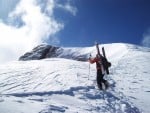Rockfax Description
Also known as Possnecker after the branch of the German and Austrian Alpine Club who first equipped it in 1912, this via ferrata is a varied and surprisingly Alpine route. Although not technically too demanding for its grade, it is long and exposed, combining some narrow chimney squeezes with some very airy face climbing. There are some quite long run-outs between wires and a couple of easy but exposed unprotected ledges.
Approach - The via ferrata is easily accessed from the top of the Sella Pass, to the northeast of the Sella Towers. This can be reached from any of the villages around the Sella. From Canazei, take the SS48 then take a left turn onto the SS242 following it all the way to the top of the Sella Pass. From Selva in Val Gardena, take the SS242 to the south, ignoring the turn-off for the Val Badia (SS243 ) and continue to the top of the Sella Pass. There is parking at the pass itself or on the first few hairpins below.
To avoid a long and arduous walk at the end of the day, a car drop is ideal for this route. Leave a car at the roadside parking below the large wall of Piz Ciavazes, then continue in the second car to the pass. If you only have one car at your disposal, it is also possible to leave the car at Piz Ciavazes and walk up to the Sella Pass, following the path which cuts through the hairpins, thus getting the ascent out of the way early in the day.
From the top of the Sella Pass, take path 649 to the left of Hotel Maria Flora towards the Sella Towers. Follow this as it contours left and nears the base of the face. Continue to reach the start of the wire below a short corner.
VF - A very short section of unprotected easy climbing allows you to reach the start of the wire. This leads diagonally left before climbing a vertical crack. Continue up iron pegs to a section of good but slightly polished holds before reaching a small unprotected ledge. Follow this right and ascend an unprotected rocky gully, with a peg in the upper section. Continue to a short ladder and ascend this to reach a striking chimney. Climb using stemples on both sides of the rift, which gets steadily narrower, before pulling round to the left onto a pulpit on the exposed rock face itself. Airy climbing leads to a second ladder. Climb this, then continue with steep, enjoyable, well-protected and exposed climbing up the face above. Continue to exit onto a large scree ledge and follow a path left, which contours the terrace.
Follow cairns and markers to reach the rock forming the second (considerably easier) half of the route. The wire is intermittent but the going straightforward as you ascend a series of loose rocky banks before exiting onto the southern shoulder of Piz Selva. Continue easily to the summit.
Descent - Follow path 649 ( - see note below) which cuts right across the plateau (it is possible to take the more scenic path which follows the ridge-line on the left, but this is considerably longer) to reach the Forcella dai Ciamorces. Continue onto path 649 to reach the Sella de Pisciadu saddle. At the fork, continue on the 649 towards Rifugio Boè to reach Forcella d'Antersass. Join path 647 and continue to reach the Val Lasties. Descend the very beautiful valley towards Rifugio Pian Schiavaneis, then at the fork follow path 656 right. Descend this through shrubs to reach a waterfall. Shortly afterwards, branch right and follow the path down to reach the main road. If you have left a car at the top of the Sella Pass, a gruelling walk awaits, following a path which cuts steeply through the hairpins, following the road in a few sections to reach the parking.
Note - There is another, shorter route down which bypasses much of the walk across the plateau. As you cross the plateau towards the Forcella dai Ciamorces, when you are level with Piz Miara's summit cross, follow a path right towards a wide gully. This route is well marked but can be difficult if visibility is poor. Be aware that there are numerous wide gullies on this section of the plateau, many of which lead to sheer drops. Descend this, overcoming boulders with the help of two short sections of cable then continue to exit into the Val Lasties. Follow this right to join the normal descent. © Rockfax
UKC Logbook Description
of ascent - 500m. Probably the oldest VF in the region and it shows. Some exposed sections on rickety ladders
Ticklists
Feedback
| User | Date | Notes | ||
|---|---|---|---|---|
| SWalls | 1 Aug, 2019 |
Show βeta
βeta: The alternative descent described as "poorly marked, difficult to find and protected by loose cable" is now very well marked with brand new cables in the steeper sections. | βeta? | |
|
Show beta
βeta: The alternative descent described as "poorly marked, difficult to find and protected by loose cable" is now very well marked with brand new cables in the steeper sections. |
||||
Logged Ascents
Guidebooks for Sella Towers
Not all climbs at crag may appear in this book 40 users have this on their wishlistPlease Login to view more details on the logged ascents
Marmolada West Ridge to Punta Penia (VF)
Grade: VF4C ***
(Marmolada)

